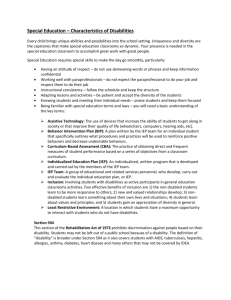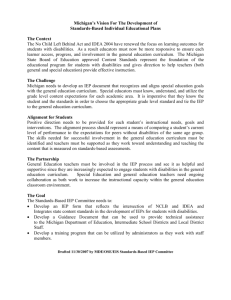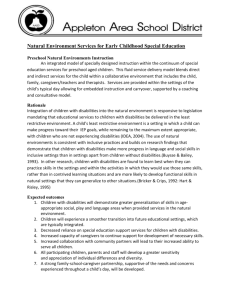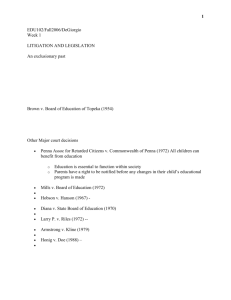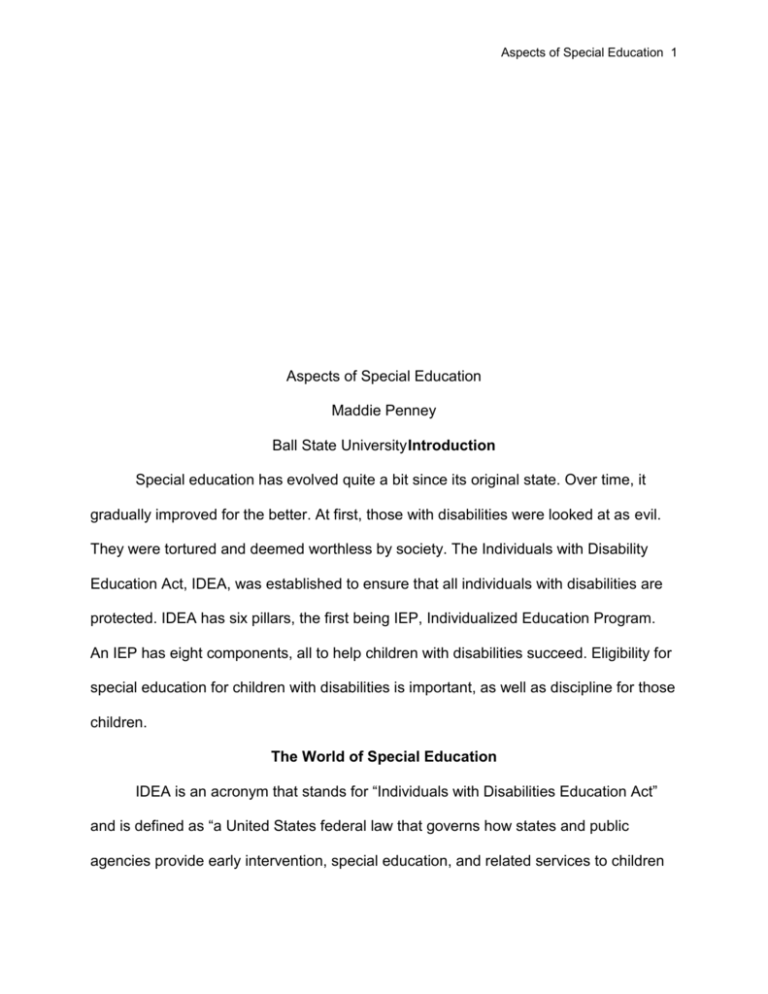
Aspects of Special Education 1
Aspects of Special Education
Maddie Penney
Ball State University Introduction
Special education has evolved quite a bit since its original state. Over time, it
gradually improved for the better. At first, those with disabilities were looked at as evil.
They were tortured and deemed worthless by society. The Individuals with Disability
Education Act, IDEA, was established to ensure that all individuals with disabilities are
protected. IDEA has six pillars, the first being IEP, Individualized Education Program.
An IEP has eight components, all to help children with disabilities succeed. Eligibility for
special education for children with disabilities is important, as well as discipline for those
children.
The World of Special Education
IDEA is an acronym that stands for “Individuals with Disabilities Education Act”
and is defined as “a United States federal law that governs how states and public
agencies provide early intervention, special education, and related services to children
Aspects of Special Education 2
with disabilities.” (National Center for Education Evaluation and Regional Assistance,
2011) IDEA is both socially and legally imperative for children with disabilities and their
families. Article 7 is basically the Indiana state version of IDEA. There are many legal
and social foundations that advocate for IDEA. Legally, there are constitutional parts
addressing education and there are court cases from the past and present that are
altering special education. Additionally, there are the IDEA statutes, and Article 7
regulations. The social foundations advocating special education include groups such
as Association for Retarded Citizens (ARC), Council for Exceptional Children (CEC),
and even the Civil Rights Movement.
The history of special education is not much to brag about. They had a rough
start with the constant mistreatment and neglect of people with special needs. There
was no compassion shown to students and even adults with disabilities. They were
seen as dirt and treated that way as well. This is extremely unfortunate as we all are
passionate for people with special needs, and we know how much joy they can bring to
a heart.
The legal foundations of IDEA include, as aforementioned, constitutional parts
addressing education, court cases from the past and present, IDEA statutes, and Article
7. Education was not included anywhere in the Constitution, the states are then left to
make appropriate decisions regarding education. The Tenth and Fourteenth
Amendments are what sparked the beginning of special education. The Tenth
Amendment says that if not stated to be Federal, the responsibility is assumed to the
State. This affects special education because every state has different rules and
regulations in their education system. The Fourteenth Amendment says that everyone
Aspects of Special Education 3
has the right to due process and equal protection. It says everyone has the right to life,
liberty, and property. Since education is considered a property, it is required to provide
free and appropriate education for everyone, including those with disabilities (Hulett,
2009).
Brown vs. Board of Education is a court case that greatly influenced the history of
special education. Brown vs. Board of Education went against the Plessy vs. Ferguson
case and said that separate is not equal. PARC vs. Pennsylvania also argued for the
special education community saying that every child with mental retardation has the
right to an education, and Mills vs. Board of Education took it one step further saying all
children with disabilities deserve free and appropriate public education as well. All of
these court cases took a stand for special education to make it what it is today (Hulett,
2009).
The social foundations of IDEA include advocacy groups such as Association for
Retarded Citizens (ARC), Council for Exceptional Children (CEC), and even the Civil
Right Movement. Social advocacy, in any situation, will benefit the cause. For special
education, social advocacy groups spread the word on the importance of special
education, it increases awareness of disabilities, and it promotes diversity in
communities! Social advocacy groups aid students with disabilities through schools and
even their lives outside of school (Hulett, 2009).
The Civil Rights Movement affected special education in that it was a time where
every aspect of discrimination was being eliminated. People recognized how horrific the
mistreatment of people with disabilities was, and they did something about it- thank
Aspects of Special Education 4
goodness! This is where all the previously mentioned court cases come into play,
especially Brown vs. Board of Education.
Article 7 differs from IDEA in that Article 7 is the Indiana state law for special
education and IDEA is the federal law for special education. They are related in that
they are both special education laws. The criteria for identification, eligibility, appropriate
education, and due process procedures under IDEA and Article 7 vary.
IDEA has six pillars that make up the components of the law. Individualized
education program or the IEP is the first and most important pillar as it is the
cornerstone of education planning and implantation. The IEP is required by law for
every student with disabilities. Each student’s IEP is reviewed accordingly for each
student based on their needs.The IEP is necessary for them to receive services related
to their disability. Also included, there is an individual family service plan for students
who are not yet in school. This must be in place and operating for every child to be
eligible for services under IDEA (Hulett, 2009, p.31-32).
The second pillar of IDEA is FAPE or free and appropriate public education. This
states that a child cannot be denied a free and appropriate education. There is a zero
reject policy in effect to ensure this. The program must be special education appropriate
for each individual child. This pillar states that children are eligible for FAPE from their
third to their twenty first birthday. FAPE ensures that education will be provided to
eligible students at the expense of the school, not of the parents of the student. Schools
are required to provide these special education services, however they do not need to
be top of the line services, just enough to cover the basics (Hulett 2009, p.32).
Aspects of Special Education 5
The third pillar of IDEA is least restrictive environment or LRE. This states that
children with disabilities are educated in the same place as all other children, unless it is
more beneficial for the child to be elsewhere. Separate classes can only happen when it
is in the best interest of the child. The child’s IEP team decides where said child is
placed, again, in his or her best interest. The LRE was established due to the
aforementioned court case Brown vs. Board of Education. This case established that
separate but equal violated the Fourteenth Amendment of the Constitution in that
separate was not equal. This court case allowed advocacy groups to work toward equal
treatment of people with disabilities so that they may be educated as much as possible
(Hulett, 2009, p.33).
The fourth pillar of IDEA is appropriate evaluation. Appropriate evaluation is
defined as “the process through which a child is determined to have a disability
requiring the support of special education and related services” (Hulett, 2009, p.33). The
evaluation helps identify a child’s specific need before the IEP is developed. IDEA sets
the standards for these evaluations. A central concern of public law was providing nondiscriminatory testing and evaluation for all which is an obstacle IDEA has had to
overcome. This evaluation may tests all areas, such as cognition, physical
development, behavioral factors, and developmental factors. These all must be taken
into consideration to determine what disabilities the child has, if any (Hulett, 2009, p.3334).
The fifth pillar of IDEA is parent and teacher participation. The family is central
the the success of special education, both the child and the child’s parents’. The
professionals in the child’s life also play an imperative role. This pillar guarantees the
Aspects of Special Education 6
right of consent and participation by the parents in every aspect of education. Parents
and teachers are a partnership who use their expertise to educate children. This pillar
allows the parents the right to any updates or documents of their child’s. The teacher is
required to share said things and include parents in on all decision making processes
(Hulett, 2009, p.35).
The sixth and final pillar of IDEA is the right to procedural safeguards. This is
also known as the right to due process, which is included in the Fourteenth Amendment
of the Constitution of the United States. The right to procedural safeguards was
established in PARC vs. Pennsylvania and Mills vs. Board of Education. This pillar
ensures that children with disabilities and their parents are guaranteed procedural
safeguards with respect to the provision of the free and appropriate education. This
benefits the students and the parents, but also the school (Hulett, 2009, p.35).
These six pillars of IDEA provide us with the structure of the special education
system we have today. They are used in every school to ensure appropriate education
to all children with disabilities. Special education has had a long and tough history, but it
is improving with each passing law. Had not all the bad things in history happened, we
would not be where we are today in regards to Special Eduction. It is imperative for
teachers to constantly be on the look out for better ways to serve their students to
improve their quality of education and quality of their life in general. IDEA makes this
possible.
RTI, Evaluation & Eligibility
When determining whether a student is eligible for special education, early
intervening services and child find are important in finding students who may be eligible
Aspects of Special Education 7
for special education services. Early intervening services or EIS is assistance for
students who have not been determined to need special education services but may
need additional support in order to succeed in the general education setting. Funds are
in the budget to help implement early intervening services for students in kindergarten
through grade twelve; these services though have an emphasis on the grade levels of
kindergarten through grade three, in order to try and intervene at an early age. EIS is
available to those students who may have been previously eligible for special education
and related services, who may not be currently receiving any special education
services, or students who may need additional behavior or academic support
(Comprehensive and coordinated early intervening services, 2008).
Child Find is the cornerstone of early intervention for students with disabilities.
Child Find has to do with identifying students who may be in need of special education
services. Each State has different procedures for how to accomplish finding children
with disabilities. Article 7 states that the activities carried out in nonpublic schools must
be comparable to activities for students with disabilities in public schools. This must be
completed in a time period that would compare to the time period of a public school,
waiting to start child find activities is unnecessary. Article 7 also states that each public
agency must keep records of how many students they evaluated, how many of those
students they determined to have disabilities, and how many students were served.
Public agencies are required to serve any student age three years of age to twenty one
years who are in need of special education and related services, regardless of their
disability (Child Find, 2008).
Aspects of Special Education 8
EIS or Early Intervening Services is designed to give extra academic and
behavioral support in order to succeed in general education. This targets students in
kindergarten through twelfth grade who do not currently need special education or
related services. According to Article 7, a public agency could go about providing early
intervention services with professional development to teachers and other school staff
so they can deliver better academic and behavioral interventions to their students. Each
public agency must report the number of students who received early intervening
services, how many students ended up receiving special education and related services
during the preceding two year period (Comprehensive and coordinated early intervening
services, 2008).
The goal behind Response to Intervention or RTI is to decrease eligibility for
special education. Parents do not need to be notified for teachers to use RTI, however if
the student starts receiving services that the other students are not receiving, the
parents must be informed. RTI is a multi-tier approach to identifying students with
learning and behavioral needs. The RTI process includes high-quality screening and
universal screening of all children in the general education classroom. The special
education teacher’s role in RTI is to support, collaborate, and brainstorm with the
general education teachers. They are not to include students that are not currently
receiving special education and related services in their lessons or groups (Speece,
2005).
RTI has three tiers differing in educational intensity. Tier 1 is the benchmark
level. Here, all students receive core curriculum and data on student progress is
collected for all students at three periods during the year. 80% of students reside in Tier
Aspects of Special Education 9
1. Tier 2 is the strategic level. The students on this level do not respond well to core
curriculum and are considered “at-risk” to fail. Supplemental instruction is provided in
this tier, where 15% of students reside. The third and final tier is Tier 3, the intensive
level. The 5% of students who do not respond to interventions at Tier 1 or Tier 2 are
given more intensive and instructive attention at this level (Hulett, 2009, p. 134).
The purpose for evaluation is to determine if a student has a disability and
whether or not he or she needs related services to aid in his or her disability. The
evaluation does not make a placement decisions, that is up to the case conference
committee or the CCC. The evaluation is just to let everyone know where this student is
at so they know where to go from there with his or her IEP. Evaluation includes
strengths, weaknesses, and current levels of performance of the student.
The 50 day schedule is an educational evaluation that must be conducted and
the CCC arranged within 50 instructional days of the date that written parental consent
is received by a licensed personnel. If the student has participated in a process that
evaluates the student’s reaction to scientific, research-based interventions then the 20
day schedule happens instead of the 50 day schedule (Special Education, 2008)
When determining whether a child is eligible for special education, a case
conference committee or CCC must determine if the student is eligible and what related
services there will be if necessary. When determining eligibility the CCC must not rely
on a single measure and must consider all information for each individual student. A
student cannot be found eligible if there has been a lack of appropriate instruction, a
limited English proficiency, or they do not otherwise meet the eligibility requirements
(Determining of eligibility, 2008).
Aspects of Special Education 10
Discipline
The process of disciplining a student in special education is complicated. The
main difference between the discipline of a general education student and a special
education student is that a special education student’s services do not stop when the
student is removed or expelled outside of the student’s regular education setting.
Although the special education student is still being disciplined, the school still must
ensure the student’s FAPE by continuing to provide the student’s special education and
related services (Hulett, 2009).
When a student violates a code of student conduct, a removal occurs. A removal
for any part of the day is considered a whole day of removal. Within the first ten days of
a student being removed, the public agency is not required to provide services for the
student, however on the eleventh day, they must begin providing services again.
Sometimes short term removal is on the student’s IEP as a part of their behavior plan,
and it is not considered a removal. That being said, the ten day rule does not apply. If
the student is able to continue working with the general education curriculum, still
receives the services addressed in their IEP, and participates with non-disabled
students as they would in their current placement, then in-school suspensions also does
not count as a removal and the ten day rule does not apply (Removals in general,
2008.)
A manifestation determination is held within ten days of any removal or placement
change after he or she violated a code of student conduct. Article 7 states, “the CCC
must meet to determine whether the student’s behavior is a manifestation of the
student’s disability” (Manifestation determinations, 2008). In order to determine whether
Aspects of Special Education 11
the student’s actions were derived from his or her disability, the CCC must meet and
decide why the student did what he or she did and if it was because of their disability, or
if the school failed to implement something on their IEP that made them lash out
(Manifestation determinations, 2008).
If manifestation is found, the CCC must administer a functional behavior assessment
(FBA) and implement a behavior intervention plan (BIP). If a behavior intervention plan
is already in effect, it should be reviewed and modified. The student should then be
placed back in his or her original placement, unless the parent and school agree to
change his or her placement as part of the modification to the behavioral intervention
plan (Manifestation determination, 2008).
The school has the power to remove a student immediately for no longer than 45
instructional days, regardless of the behavior’s manifestation if the student is carrying a
weapon, knowingly possessed or uses illegal drugs or sells controlled substances, or
has inflicted serious bodily injury upon another person while at school. The public
agency must then notify the parents and provide the parent with notice of procedural
safeguards, and hold a manifestation meeting regarding the student’s conduct. The
CCC conducted after immediate removal must determine how the student can continue
to participate in the general education curriculum in another setting, how they will
continue in progress toward meeting goals set in the IEP, and also receive functional
behavior assessments and behavioral intervention services to address the violation so it
does not happen again (Interim alternative educational setting; weapons, drugs, and
serious bodily injury).
Aspects of Special Education 12
Behavior plays a huge part in special education and it is not taken less seriously than
discipline in general education. However, it is handled differently. This is just another
thing that makes special education so unique. It is important to see how effective the
functional behavior assessments (FBA) and behavior intervention plans (BIP) are in
disciplining students with disabilities. These discipline services are truly necessary to
give students with disabilities equal opportunities for success.
Conclusion
The IDEA, a student’s IEP, evaluation of a student to find if he or she is eligible,
and discipline are all various, important elements of special education. Once a child is
evaluated and found eligible for special education and related services he or she is
protected under the IDEA. An IEP is created for a student with a disability to aid in the
success of the student by providing him or her with goals and services. The student’s
IEP may also contain a BIP if his or her behavior is likely to result in a violation of
student conduct. Discipline strategies used for students with disabilities are very similar,
with only a few differences, to the way a non-disabled student would be disciplined.
Without these certain aspects of special education, the services provided to students
with disabilities would not be possible. Special education services are very important to
give students with disabilities equal opportunities for success.
References
Hulett, K. E. (2009). The legal aspects of special education. Upper Saddle River, NJ:
Pearson Prentice Hall
National Center for Education Evaluation and Regional Assistance, (2011). National
Assessment of IDEA Overview. NCEE 2011-4026. National Center For
Education
Evaluation And Regional Assistance.
Aspects of Special Education 13
Special Education, 511 Ind. Admin. Code 7-40-1
Special Education, 511 Ind. Admin. Code 7-40-2
Special Education, 511 Ind. Admin. Code 7-40-3
Special Education, 511 Ind. Admin. Code 7-40-6
Special Education, 511 Ind. Admin. Code 7-44-1
Special Education, 511 Ind. Admin. Code 7-44-5
Special Education, 511 Ind, Admin. Code 7-44-6
Speece, D.L., Case, L.P., & Molloy, D.E. (2003). Responsiveness to general education
instruction as the first gate to learning disabilities identification. Learning
Disabilities Research & Practice, 18(3), 147-156.



